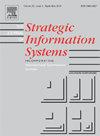How do IT misalignments and IT ambidexterity imbalances lead to organizational agility? Substitution, complementarity, and contingency interdependencies with a configurational approach
IF 11.8
2区 管理学
Q1 COMPUTER SCIENCE, INFORMATION SYSTEMS
引用次数: 0
Abstract
Two main and separate Information Systems (IS) research streams have investigated the link between information technology (IT) and organizational agility via the concepts of IT ambidexterity and IT alignment. This study examines IT ambidexterity and IT alignment for agility by breaking down each concept and investigating questions regarding the balance between exploitation and exploration alongside those of fit between the IT and business domains. To do so, we apply configurational theory inductively to empirically identify and theorize how interdependencies between capability types (i.e., exploitation and exploration) and domains (i.e., IT and business) lead to agility. A fuzzy set qualitative comparative analysis (fsQCA) of data gathered through a survey of manufacturing SMEs unveils three specific forms of interdependencies: (1) complementarity of exploration between the IT and business domains; (2) substitution of exploitation between the two domains; and (3) contingent effects (positive vs. negative) of each, IT exploitation and IT exploration, depending upon the intensity of the remaining elements. These interdependencies enable the derivation of four theoretically meaningful propositions for future research that reconcile inconsistent findings in both research streams. Overall, this study contributes beyond past research focused on either IT ambidexterity or IT alignment by providing a compelling parsimonious theoretical explanation of how – and which – IT misalignments and imbalances between exploitation and exploration lead to high agility and which do not. These insights are also of high practical value, as they provide manufacturing SMEs with more options to reach agility.
IT错位和IT双敏捷性失衡是如何导致组织敏捷性的?使用配置方法进行替代、互补和偶然性相互依赖
两个主要的和独立的信息系统(IS)研究流通过IT双灵巧性和IT一致性的概念调查了信息技术(IT)和组织敏捷性之间的联系。本研究通过分解每个概念,并调查有关开发和探索之间的平衡以及IT和业务领域之间的契合的问题,来检查IT的两重性和敏捷性的IT一致性。为了做到这一点,我们运用配置理论归纳地识别和理论化能力类型(例如,开发和探索)和领域(例如,IT和业务)之间的相互依赖如何导致敏捷性。通过对制造业中小企业调查收集的数据进行模糊集定性比较分析(fsQCA),揭示了三种特定的相互依赖形式:(1)IT和业务领域之间的探索互补性;(2)两个领域之间的替代利用;(3) IT开发和IT探索的偶然效应(积极或消极),取决于其余要素的强度。这些相互依存关系使得四个理论上有意义的命题的推导为未来的研究,调和不一致的发现在两个研究流。总的来说,这项研究的贡献超越了过去关注IT双敏捷性或IT一致性的研究,它提供了一个令人信服的简洁理论解释,说明了开发和探索之间的IT错位和不平衡如何以及哪些会导致高敏捷性,哪些不会。这些见解也具有很高的实用价值,因为它们为制造业中小企业提供了更多实现敏捷性的选择。
本文章由计算机程序翻译,如有差异,请以英文原文为准。
求助全文
约1分钟内获得全文
求助全文
来源期刊

Journal of Strategic Information Systems
工程技术-计算机:信息系统
CiteScore
17.40
自引率
4.30%
发文量
19
审稿时长
>12 weeks
期刊介绍:
The Journal of Strategic Information Systems focuses on the strategic management, business and organizational issues associated with the introduction and utilization of information systems, and considers these issues in a global context. The emphasis is on the incorporation of IT into organizations'' strategic thinking, strategy alignment, organizational arrangements and management of change issues.
 求助内容:
求助内容: 应助结果提醒方式:
应助结果提醒方式:


